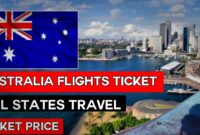Senior Travel Service caters to a growing market segment with unique needs and desires. Understanding these needs is crucial for designing successful and fulfilling travel experiences for older adults. This exploration delves into the market analysis, traveler preferences, package design, marketing strategies, and the role of technology in enhancing senior travel.
The senior travel market presents significant opportunities for businesses willing to adapt to the specific requirements and preferences of this demographic. From accessibility concerns to culturally enriching experiences, creating tailored travel packages is key to success. This guide examines the various aspects of providing exceptional senior travel services, offering insights into effective strategies and best practices.
Market Analysis of Senior Travel Services
The senior travel market represents a significant and rapidly expanding sector within the broader tourism industry. Understanding its size, growth drivers, segmentation, and competitive landscape is crucial for businesses aiming to succeed in this lucrative market. This analysis explores these key aspects to provide a comprehensive overview.
Current Market Size and Growth Potential
The global senior travel market is substantial and experiencing robust growth. While precise figures vary depending on the source and definition of “senior traveler,” market research consistently indicates a significant and expanding market. Factors such as increasing life expectancy, improved health and financial well-being among older adults, and a rising desire for fulfilling travel experiences contribute to this expansion. For example, a report by [insert reputable market research firm and report name here] projected a [insert percentage]% growth rate between [insert years] driven primarily by increased disposable income among retirees in developed nations and the burgeoning middle class in developing countries. This translates into a market valued at [insert estimated market value in USD] and projected to reach [insert projected market value in USD] by [insert year].
Key Demographic Trends Influencing Senior Travel Preferences
Several demographic trends significantly shape the preferences of senior travelers. The increasing prevalence of active aging, where individuals maintain a healthy and engaged lifestyle well into their later years, fuels demand for adventure travel and physically demanding activities. Simultaneously, the growing number of multigenerational families leads to a demand for travel options that cater to diverse age groups and interests. Furthermore, technological advancements, including improved accessibility to online booking platforms and mobile travel apps, have empowered senior travelers to plan and manage their trips independently. The rise of “experience-driven” travel, prioritizing meaningful experiences over material possessions, further shapes the market, with seniors seeking cultural immersion, educational tours, and opportunities for personal growth.
Comparison of Senior Travel Market Segments
The senior travel market encompasses diverse segments, each with unique characteristics and appeal. Adventure travel caters to active seniors seeking challenging physical activities like hiking and trekking. Cruises offer a convenient and all-inclusive travel experience, appealing to a broader range of seniors. Escorted tours provide a structured and hassle-free travel experience, particularly suitable for seniors traveling alone or with limited mobility. Each segment targets specific needs and preferences. Adventure travel requires a higher level of physical fitness and often focuses on unique destinations. Cruises provide a relaxing experience with various amenities, while escorted tours offer convenience and social interaction. The choice depends on individual preferences, physical abilities, and budget.
Competitive Landscape and Major Players
The senior travel market is competitive, with established players and emerging companies vying for market share. Major players often leverage their extensive networks, established brand reputation, and specialized services to attract senior travelers. These companies often employ targeted marketing strategies, emphasizing safety, convenience, and accessibility in their offerings. Strategies include specialized travel packages catering to specific senior interests, partnerships with healthcare providers to ensure medical assistance, and the development of accessible travel options. Examples of major players include [List at least 3 major players with brief descriptions of their strategies].
Senior Travel Market Segmentation: A Summary
| Segment | Market Size (Estimated) | Growth Rate (Projected) | Key Competitors |
|---|---|---|---|
| Adventure Travel | [Insert estimated market size, e.g., $X billion] | [Insert projected growth rate, e.g., Y%] | [List key competitors, e.g., Abercrombie & Kent, G Adventures] |
| Cruises | [Insert estimated market size, e.g., $Z billion] | [Insert projected growth rate, e.g., W%] | [List key competitors, e.g., Carnival Corporation, Royal Caribbean] |
| Escorted Tours | [Insert estimated market size, e.g., $A billion] | [Insert projected growth rate, e.g., B%] | [List key competitors, e.g., Trafalgar Tours, Cosmos Tours] |
Designing Senior-Friendly Travel Packages
Creating enjoyable and safe travel experiences for senior citizens requires careful consideration of their specific needs and preferences. This involves designing itineraries that balance engaging activities with ample rest, selecting accessible accommodations and transportation, and incorporating culturally relevant experiences that resonate with this demographic. A well-designed package minimizes potential health risks and ensures a positive and memorable travel experience.
Sample Seven-Day Senior-Focused Tour Itinerary: “Charming Coastal California”
This itinerary focuses on a relaxed pace, minimizing strenuous activities and maximizing opportunities for relaxation and cultural immersion. It prioritizes accessibility and incorporates elements to cater to diverse senior interests.
| Date | Location | Activities | Accessibility Considerations |
|---|---|---|---|
| Day 1 | San Francisco | Arrival, check-in at accessible hotel near Fisherman’s Wharf. Gentle stroll along the Embarcadero, enjoying views of Alcatraz and the bay. Optional: Wheelchair-accessible boat tour of the bay. Evening: Relaxed dinner at a restaurant with accessible seating. | Hotel with ramps, elevators, and accessible rooms. Wheelchair-accessible transportation options available. |
| Day 2 | San Francisco | Visit to the California Academy of Sciences (accessible exhibits and ramps). Lunch at a restaurant with accessible seating. Afternoon: Relaxing ride on a vintage cable car (consider alternatives for those with mobility issues). Evening: Optional: Attend a performance at a theatre with accessible seating. | Academy of Sciences offers wheelchair rentals and accessible restrooms. Alternative transportation options (e.g., taxi) available for cable car. |
| Day 3 | Monterey & Carmel | Scenic drive along the iconic 17-Mile Drive (consider a van with wheelchair lift for those needing it). Visit the Monterey Bay Aquarium (accessible exhibits and facilities). Afternoon: Relaxing walk along Carmel Beach. Evening: Dinner in Carmel-by-the-Sea. | Accessible restrooms and facilities at the Aquarium. Wheelchair-accessible transportation options available for the 17-Mile Drive. |
| Day 4 | Big Sur | Scenic drive along Highway 1 (stopping at viewpoints with accessible parking and viewing areas). Visit Pfeiffer Big Sur State Park (accessible trails and picnic areas). Afternoon: Relaxation and optional nature walk. Evening: Dinner at a restaurant with accessible seating. | Prioritize viewpoints with accessible parking. Choose shorter, accessible trails within the park. |
| Day 5 | San Simeon | Visit Hearst Castle (accessible areas available; pre-booking recommended). Afternoon: Relaxation by the pool or at the hotel. Evening: Dinner at the hotel or a local restaurant with accessible seating. | Hearst Castle offers accessible tours and transportation. Pre-booking essential to secure accessible accommodations. |
| Day 6 | Santa Barbara | Drive to Santa Barbara. Visit the Santa Barbara Mission (partially accessible). Afternoon: Stroll along State Street, enjoying the shops and architecture. Evening: Farewell dinner at a restaurant with ocean views and accessible seating. | Consider the accessibility limitations of the Mission. Plan alternative activities if needed. |
| Day 7 | Departure | Check out from the hotel and depart from Santa Barbara Airport (accessible facilities available). | Accessible transportation to the airport should be pre-arranged. |
Accessibility Features in Transportation and Accommodation
Senior-friendly travel packages prioritize accessibility in all aspects of the journey. This includes selecting hotels with ramps, elevators, and accessible rooms, ensuring that transportation options, such as buses, trains, and rental cars, are equipped to accommodate wheelchairs or other mobility devices. Consideration should also be given to the availability of accessible restrooms and other facilities at all locations visited. For example, using a wheelchair-accessible van for excursions in locations with limited public transport options, or ensuring hotels have grab bars in bathrooms.
Incorporating Culturally Relevant Experiences
The itinerary should incorporate culturally relevant experiences that resonate with seniors’ interests and preferences. This could involve visits to historical sites, museums, art galleries, or participation in local cultural events. For instance, in the “Charming Coastal California” itinerary, visits to the Monterey Bay Aquarium and Hearst Castle offer engaging cultural experiences tailored to various interests. Choosing destinations with historical significance, local arts and crafts demonstrations, or opportunities to interact with local communities will enrich the experience.
Health and Safety Risks and Mitigation Strategies
Potential health and safety risks for senior travelers include falls, medical emergencies, and heatstroke. Mitigation strategies include selecting accommodations and transportation with appropriate safety features, providing emergency contact information and medical assistance, and advising travelers on heat safety precautions. Travel insurance that covers medical emergencies and evacuation is highly recommended. For example, including a daily check-in system with tour guides, providing readily available first-aid kits, and offering travel insurance are key safety measures.
Marketing and Promotion Strategies
Reaching senior travelers requires a nuanced approach, focusing on channels and messaging that resonate with their preferences and lifestyle. This necessitates a multi-pronged strategy that leverages both traditional and digital marketing techniques to effectively communicate the value proposition of our senior travel services. Success hinges on understanding their needs and tailoring our communication to build trust and excitement.
Targeted Marketing Channels and Messaging
Our marketing plan will prioritize channels known for strong engagement with the senior demographic. Print media, such as targeted magazines and newspapers frequented by seniors (e.g., AARP publications), will be utilized for high-impact visuals and detailed information. Direct mail campaigns, personalized to specific interests and travel styles, will offer a more intimate touch. Digital marketing will focus on user-friendly websites and targeted online advertising on platforms frequented by older adults, but with careful consideration of accessibility features. Messaging will emphasize comfort, security, and enriching experiences, highlighting aspects such as accessible accommodations, well-planned itineraries, and expert support throughout the journey. We will avoid overly trendy language and instead opt for clear, concise, and reassuring communication.
Examples of Effective Marketing Materials
A brochure could feature large, high-quality photographs showcasing serene landscapes, comfortable accommodations, and smiling seniors enjoying themselves on our tours. The text would focus on the ease and convenience of our services, the safety measures in place, and the unique cultural or historical experiences offered. Our website would incorporate similar imagery, but also feature detailed itineraries, testimonials from past travelers, and interactive maps. A virtual tour option, allowing potential clients to explore destinations from the comfort of their homes, would enhance engagement.
Social Media Engagement with Senior Travelers
While seniors may not be the largest group on every social media platform, Facebook and Instagram, in particular, offer valuable opportunities. Content should be visually appealing, easy to understand, and focus on sharing positive experiences and building a sense of community. Regularly posting high-quality images and videos showcasing happy travelers, coupled with engaging captions, can build trust and generate interest. Running contests or giveaways can also increase engagement and brand awareness. Importantly, the content needs to be easily accessible, with large fonts and clear visuals. We will also monitor and respond to comments and messages promptly, fostering a sense of personal connection.
Comparison of Advertising Strategies
Television advertising, though expensive, can reach a broad audience, but targeting specific senior demographics requires careful channel selection and timing. Print advertising offers a more targeted approach, allowing for precise geographic and demographic targeting. Digital advertising, through platforms like Facebook and Google Ads, offers highly targeted campaigns based on interests, demographics, and online behavior. Each strategy has its strengths and weaknesses; a balanced approach leveraging the advantages of each is key to maximizing reach and impact. A/B testing different ad creatives and channels will be crucial to optimizing our spending.
Compelling Visuals and Descriptive Text
Imagine a photograph of a group of seniors laughing together while enjoying a scenic view from a comfortable tour bus. The caption could read: “Experience the joy of travel without the stress. Our expertly planned tours offer comfort, security, and unforgettable memories.” Another image could depict a senior couple relaxing in a luxurious hotel room, overlooking a breathtaking vista. The accompanying text could emphasize the ease and convenience of our all-inclusive packages. The overall tone should be positive, reassuring, and evocative, focusing on the emotional benefits of travel and the peace of mind offered by our services. We will use warm, inviting color palettes and avoid cluttered designs to create a sense of calm and serenity.
Last Recap
Ultimately, providing exceptional senior travel services requires a holistic approach that combines market understanding, thoughtful package design, effective marketing, and a seamless integration of technology. By addressing the unique needs and preferences of senior travelers, businesses can create memorable and enriching experiences that foster independence, exploration, and connection.




